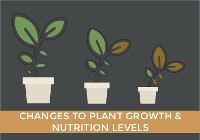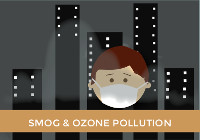The main effect of increased greenhouse gas emissions is global warming. Carbon dioxide, methane, nitrous oxide and fluorinated gases all help trap heat in the Earth's atmosphere as a part of the greenhouse effect. The Earth's natural greenhouse effect makes life as we know it possible. However, human activities, primarily the burning of fossil fuels and deforestation, have intensified the greenhouse effect, causing global warming.
Effects of increased greenhouse gas emissions
Increases in the different greenhouse gases have other effects apart from global warming including ocean acidification, smog pollution, ozone depletion as well as changes to plant growth and nutrition levels.
Global warming
Greenhouse gas levels have been increasing since the start of the Industrial Revolution, but over the last few decades growth has been particularly fast. Total greenhouse gas emissions have increased by about 80% since 1970, creating a radiative forcing of 2838 mW/m^2 equivalent to an atmospheric concentration of 473 ppm CO2e.
With increasing levels of greenhouse gases being added daily, the greenhouse effect is now enhanced to the point where too much heat is being kept in the Earth's atmosphere. The heat trapped by carbon dioxide and other greenhouse gases has increased surface temperatures by 0.75°C (1.4°F) over the last 100 years.
Global warming is harming the environment in several ways including:
- Desertification
- Increased melting of snow and ice
- Sea level rise
- Stronger storms and extreme events
Ocean Acidification
Increases in carbon dioxide levels have made the world's oceans 30% more acidic since the Industrial Revolution. The ocean serves as a sink for this gas and absorbs about a quarter of human carbon dioxide emissions, which then goes on to react with seawater to form carbonic acid. So as the level of carbon dioxide in the atmosphere rises, the acidification of the oceans increases.
Changes to plant growth and nutrition levels
Since plants need carbon dioxide to grow, if there are higher amounts in the air, plant growth can increase. Experiments where carbon dioxide concentrations were raised by around 50% increased crop growth by around 15%. Higher levels of carbon dioxide makes carbon more available, but plants also need other nutrients (like nitrogen, phosphorus, etc.) to grow and survive. Without increases in those nutrients as well, the nutritional quality of many plants will decrease. In different experiments with elevated carbon dioxide levels, protein concentrations in wheat, rice, barley, and potato tubers, decreased by 5-14%.
Smog and ozone pollution
Over the last century, global background ozone concentrations have become 2 times larger due mainly to increases in methane and nitrogen oxides caused by human emissions. At ground level, ozone is an air pollutant that is a major component of smog which is dangerous for both humans and plants.
Long-term ozone exposure has also been shown to reduce life expectancy. 362000-700000 of annual premature cardiopulmonary deaths worldwide are attributable to ozone. Recent studies estimate that the global yields of key staple crops, like soybean, maize (corn), and wheat, are being reduced by 2-15% due to present-day ozone exposure.
Ozone layer depletion
Nitrous oxide damages the ozone layer and is now the most important ozone depleting substance and the largest cause of ozone layer depletion. This is because CFCs and many other gases that are harmful for the ozone layer were banned by the Montreal Protocol (MP) which has reduced their atmospheric concentration. Nitrous oxide is not restricted by the MP, so while the levels of other ozone depleting substances are declining, nitrous oxide levels are continuing to grow.
More info:
Drivers and Impacts of Greenhouse Gas Emissions - Environment and Climate Change Canada
Climate Change: Effects - NASA





